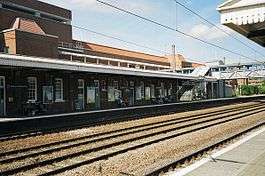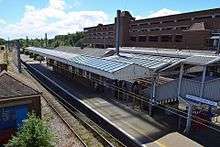Welwyn Garden City railway station
| Welwyn Garden City | |
|---|---|
 Welwyn Garden City Platform 3 | |
| Location | |
| Place | Welwyn Garden City |
| Local authority | Borough of Welwyn Hatfield |
| Coordinates | 51°48′04″N 0°12′14″W / 51.801°N 0.204°WCoordinates: 51°48′04″N 0°12′14″W / 51.801°N 0.204°W |
| Grid reference | TL240129 |
| Operations | |
| Station code | WGC |
| Managed by | Great Northern |
| Number of platforms | 4 |
| DfT category | C1 |
|
Live arrivals/departures, station information and onward connections from National Rail Enquiries | |
| Annual rail passenger usage* | |
| 2012/13 |
|
| 2013/14 |
|
| 2014/15 |
|
| 2015/16 |
|
| 2016/17 |
|
| History | |
| Key dates | Opened 20 September 1926 |
| Original company | London and North Eastern Railway |
| Post-grouping | London and North Eastern Railway |
| 1 September 1920 | First station Welwyn Garden City Halt opened |
| 20 September 1926 | First station closed; present station Welwyn Garden City opened |
| National Rail – UK railway stations | |
| * Annual estimated passenger usage based on sales of tickets in stated financial year(s) which end or originate at Welwyn Garden City from Office of Rail and Road statistics. Methodology may vary year on year. | |
|
| |
Welwyn Garden City railway station serves the town of Welwyn Garden City in Hertfordshire, England. It is 20 miles 25 chains (32.69 km) from London King's Cross on the East Coast Main Line.[1] Welwyn Garden City station is managed and served by Great Northern.
History
A station named Welwyn Junction was opened with the Hertford and Welwyn Junction Railway on 1 March 1858. This station ceased to be used for services on 1 September 1860.[2]
A halt named Welwyn Garden City Halt opened on 1 September 1920,[2] shortly after the town was incorporated; this was on the now defunct Luton/Dunstable branch line,[3] slightly further north than the present station. This line cuts west and north through Sherrardspark Wood, and on towards Wheathampstead via what is now Ayot Greenway.
The present Welwyn Garden City station opened on 20 September 1926; Welwyn Garden City Halt was closed at the same time.[2][4] Prior to this, services to Luton and the Hertford line, which cut east through the town, were handled from nearby Hatfield. The Hertford branch line was closed to rail passenger traffic in 1951 and to goods in 1966, whilst the Dunstable line fell victim to the Beeching Axe in April 1965 (although goods traffic survived until 1971).[5]
When the Howard Centre shopping centre was opened in October 1990, the original ticket hall was demolished. It is now inside the Howard Centre with steps linking down to the original bridge and then platforms.
The line near the station has seen two serious train crashes, one in 1935, and another in 1957.
Facilities
Welwyn Garden City was semi-refurbished by First Capital Connect during 2007, which saw improved lighting installed, new bus -shelter-style waiting rooms and improved toilets on each platform island. The refurbishments also saw the installation of Ticket Gates.[6] There is also a station cafe located on Platforms 1 and 2, recently reopened as "The Garden Line".
The station has direct access to the Howard Centre. The shopping centre also incorporates the station's ticket office on the first floor. There are 4 ticket machines; 3 standard touch screen machines and one "card only" machine. There are also help-points located within the station.[7]
Towards the end of 2007 Welwyn Garden City was awarded "Secure Station" status, along with many other stations along the Great Northern route as part of a stations improvement programme. As part of this award, many additional cameras were installed at the station.[8]
Services
Monday to Saturdays, trains operate half-hourly on Great Northern's "London-Cambridge/Peterborough" line towards London Kings Cross and hourly towards Cambridge and Peterborough respectively. London-bound trains normally call only at Hatfield, Potters Bar and Finsbury Park en route to the capital, whilst northbound trains call at all stations beyond here toward their respective destinations. On Sundays there is an hourly service southbound to London and northbound to Cambridge (passengers for stations to Peterborough must change at Stevenage or Hitchin).[9]
Welwyn Garden City is a terminus for Great Northern's "London - Welwyn line" stopping service. Trains depart every 20 minutes to Moorgate in London on weekdays until 10pm, then running every half-hour.[10] A few weekday peak services run to/from Kings Cross serving intermediate stations also operate.
A rail flyover was constructed south of the station in 1977 when the line was electrified to allow the Moorgate trains to arrive and depart from Platform 4 without conflicting with main line trains. There is also a limited stop service from Welwyn Garden City to London King's Cross on weekday nights, notably just after 10pm where the service only calls at Finsbury Park and 11pm where the service only calls at Potters Bar.[11] The stopping trains used to run to Kings Cross in the late evening and at weekends until the December 2015 timetable change, but now serve the Moorgate branch at all times.[12]
The station is also served by various buses operated by Arriva, Centrebus and Uno (bus company)
After the completion of the Thameslink Programme in 2018 a 2tph service from Maidstone East to Welwyn Garden City is proposed.[13]
Station layout
The Up Yard sidings[14] at Welwyn Garden City consists of 6 unelectrified roads, currently used for the twice-weekly reversal of empty gypsum wagons returning from Hitchin to Peak Forest along occasional Rail tamper units and departmental wagon storage.

The EMU sidings,[14] just north of the station, consists of 9 electrified roads with the 8-car 317/365's able to use only 5 of the sidings because if they used the other sidings, they would block the siding next to it.[4]
Platforms 2 (southbound) and 3 (northbound) are in regular use for services to/from London Kings Cross, Peterborough and Cambridge. Platform 3 is also used for terminating trains for the carriage sidings and where trains from the carriage sidings form into passenger service - a few southbound trains start from here at peak times rather than platform 4 as they can access the flyover onto the Up Slow line.
Platform 4 is used for services to/from Moorgate, also used for terminating trains for the carriage sidings and where trains from the carriage sidings form into passenger service.[4]
Platform 1 (the outer face of the up island) sees only occasional use as it has no direct access for northbound (down) terminating trains or empty units coming into service from the carriage sidings. The latter must cross over the flyover into the up reversing siding and then shunt back into the platform via the reversing line.
The West exit off the passenger footbridge leads into the Howard centre where the main station ticket office is located on the first floor while the East exit leads to the Broadwater industrial area.
Route
| Preceding station | Following station | |||
|---|---|---|---|---|
| Hatfield | Thameslink Great Northern Route |
Welwyn North | ||
| Hatfield | Great Northern Northern City Line |
Terminus | ||
| Disused railways | ||||
| Hatfield Line and station open |
Great Northern Railway Dunstable Branch |
Ayot Line and station closed | ||
| Great Northern Railway Hertford and Welwyn Junction Railway |
Cole Green Line and station closed | |||
Oyster card ticketing
Oyster cards are currently not accepted on journeys to Welwyn Garden City. The train operating company, Govia, agreed to extend London Zonal Fares to include Potters Bar by September 2015 when they won the Great Northern franchise. More recently Transport for London indicated that Welwyn Garden City and Potters Bar are two of the top four priority stations for the extension of London Zonal Fares and that introduction of the required software is expected to be completed by the end of 2018.[15]
References
- ↑ Padgett, David (October 2016) [1988]. Brailsford, Martyn, ed. Railway Track Diagrams 2: Eastern (4th ed.). Frome: Trackmaps. map 15A. ISBN 978-0-9549866-8-1.
- 1 2 3 Butt 1995, p. 244
- ↑ Conolly 1976, p. 11, section F2
- 1 2 3 Disused Stations - Welwyn Garden City Halt Disused Stations; Retrieved 2014-02-11
- ↑ Body 1986, p. 176
- ↑ http://www.firstcapitalconnect.co.uk/Main.php?sEvent=News&sFileName=News.php&iId=82
- ↑ http://www.howardcentre.co.uk/getting-here/find-us
- ↑ http://www.firstcapitalconnect.co.uk/Main.php?sEvent=News&sFileName=News.php&iId=58
- ↑ Table 25 National Rail timetable, May 2016
- ↑ Table 24 National Rail timetable, May 2016
- ↑ http://www.firstcapitalconnect.co.uk/Main.php?sEvent=Timetables&crs_code=WGC
- ↑ "Seven-day-a-week service to the City better for late-returning commuters and weekend shoppers"Great Northern/Thameslink website article 5 November 2015; Retrieved 22 August 2016
- ↑ London and South East Route Utilisation Strategy page 72
- 1 2 Network Rail (2015-06-06). London North Eastern Route Sectional Appendix. Module LN2. p. 18.
- ↑ http://www.whtimes.co.uk/motoring/oyster-card-coming-to-welwyn-garden-city-hatfield-and-potters-bar-1-4614704
Bibliography
- Body, G. (1986). PSL Field Guides - Railways of the Eastern Region Volume 1. Wellingborough: Patrick Stephens Ltd. ISBN 0-85059-712-9.
- Butt, R.V.J. (1995). The Directory of Railway Stations. Yeovil: Patrick Stephens Ltd. ISBN 1-85260-508-1. R508.
- Conolly, W. Philip (January 1976). British Railways Pre-Grouping Atlas and Gazetteer (5th ed.). Shepperton: Ian Allan. ISBN 0-7110-0320-3. EX/0176.
External links
| Wikimedia Commons has media related to Welwyn Garden City railway station. |
- Train times and station information for Welwyn Garden City railway station from National Rail
- Timetable downloads for Welwyn Garden City from Great Northern
- Welwyn Garden City Train station information from Great Northern